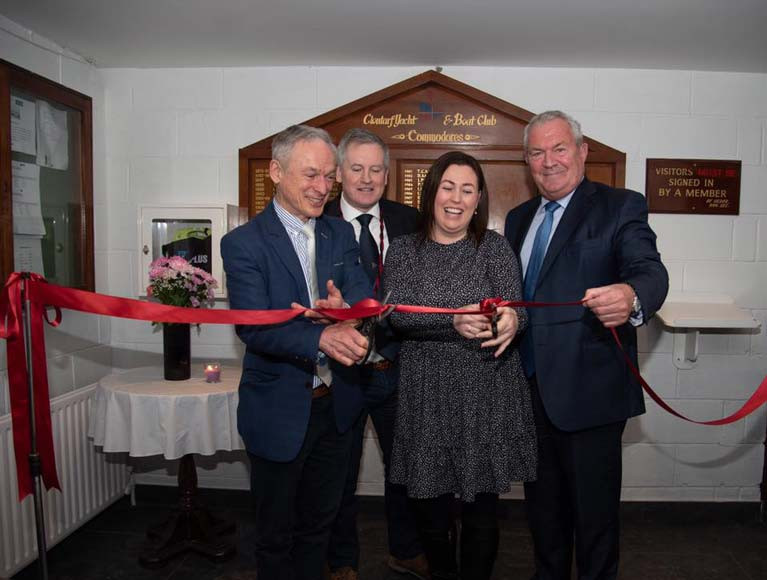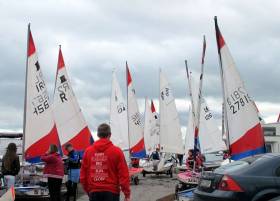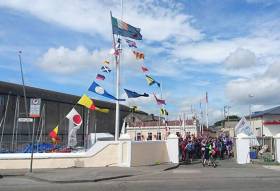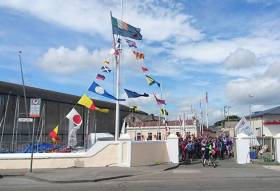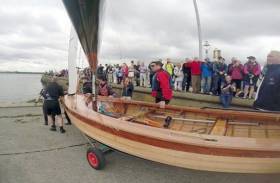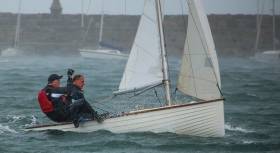Displaying items by tag: Clontarf Yacht & Boat Club
Skerries Sailors Take Gold and Silver at 2022 E-Boat National Championships at Clontarf Yacht and Boat Club
The E-Boat National Championships made a long-awaited return to the very hospitable and welcoming waters of Clontarf Yacht & Boat Club (CYBC) on the weekend of 27 and 28 August.
The last National Championships were hosted by CYBC in 2019, with Paul Hick and his team on EasyGo taking Gold on that occasion. With four boats travelling from Skerries and six representing the host club, there was very hot competition for the Championship trophy!
With six races to be run over three days in very fluky wind conditions forecast between 1 and 5 knots, the Race Officer, Ian Sargent, had a difficult task ahead of him for the weekend. However, strategically setting the courses in the bay, with three Offset courses on the Saturday and three Olympic courses on the Sunday, he pulled it off to perfection!
 Close E Boat racing under spinnaker at Clontarf
Close E Boat racing under spinnaker at Clontarf
Gigantic clumps of seaweed through the middle of the bay, accompanied by algae of all shapes and sizes, presented their own challenges for competitors, with many boats taking turns in getting their keels and/or their rudders encircled in said substance … much to their annoyance but to the absolute glee of the competing boats! Rumours of sabotage by the locals were vigorously refuted!
Day 1, in unexpectedly moderate winds, saw the Skerries teams of EasyGo and Eaglet score bullets in the three races, with EasyGo scoring a bullet in the first and second race and Eaglet taking it in the third. At the end of the day, Skerries boat EasyGo had a clear lead with 4 points, followed by fellow Skerries boat Eaglet and CYBC boat Eureka on 9 points each. While first place was heading towards EasyGo, second place was there to be fought for.
Day 2 saw lighter conditions with Skerries boats EasyGo, Eaglet and Aoife scoring a bullet each in the three races. This saw Paul Hick of EasyGo with his team of Paula McNamee, Pat Furlong and Tom Adams continue their fine performance of 2019 and take first position overall with 8 points. Bernie Grogan of Eaglet and her team of Steven Woolnough, Pawel Muszynski and Matt O’Kane took second on 12 points - but only just about - as the wiley team of Shane Russell, Dave Carolan and Suzanne Collins on the appropriately named Wylie Coyote also scored 12 points. But having scored a bullet in the last race, the silver went to Eaglet, with Wylie Coyote had to settle for third place (Suzanne being the second generation of her family to manage the foredeck on Wylie Coyote, a boat previously owned by her father!).
 The crew of EasyGo, who took gold - Paul Hick (skipper), Tom Adams, Paula McNamee and Pat Furlong. Also in the picture is Claire Meany, Vice-Commodore of Clontarf SBC
The crew of EasyGo, who took gold - Paul Hick (skipper), Tom Adams, Paula McNamee and Pat Furlong. Also in the picture is Claire Meany, Vice-Commodore of Clontarf SBC
 The crew of Eaglet, who took silver - Bernie Grogan (skipper), Pawell Muszynski, Steven Woolnough and Matt O'Kane
The crew of Eaglet, who took silver - Bernie Grogan (skipper), Pawell Muszynski, Steven Woolnough and Matt O'Kane  The crew of Wylie Coyote, who took bronze - Dave Carolan, Suzanne Collins and Shane Russell (skipper)
The crew of Wylie Coyote, who took bronze - Dave Carolan, Suzanne Collins and Shane Russell (skipper)
A big thanks goes to the members and sailors of CYBC for their camaraderie and warm welcome, and all the boats and crews for making the 2022 National Championship a first-class event.
The E-Boat class are always open to new members, both crew and helms and anyone interested in buying one of the best one-design yachts racing in Dublin!
Clontarf Yacht and Boat Club have just celebrated the completion of key renovation work with an official ribbon-cutting ceremony attended by special guests and supporters, Edel Currie of Dublin Port, Minister Richard Bruton and Richard Nolan of Nolan’s Supermarket.
Welcoming the guests and members to the Club, Commodore Aidan Cronin said, “Our Club is 145 years old and while we value our history and tradition, it is also essential that we move with the times. Over the past number of years, it became increasingly apparent that our facilities were not fit for purpose. Our growing female membership had to contend with a limited number of showers and a subpar changing room. Our regular visitors from the CRC and St. Michael’s House, as well as other visitors to the Club with extra needs or mobility challenges, had very limited facilities. Yet we knew that making such improvements would be a huge undertaking for a volunteer-run Club with limited income.”
The Club was successful in applying for a Sports Capital Grant and then embarked on almost year-long fundraising programme with events and members contributing to make up the final shortfall.
According to the Commodore, Aidan Cronin, “Our members have been central to the successful delivery of this project with their generosity in offering their expertise, their knowledge and their time. The Sports Capital Grant was essential but it was only the beginning and ultimately the entire membership was critical to the success of the project as they fundraised and contributed to meeting the costs.”
In addition to the refurbishment of the women’s changing facilities, two chimney breasts had to be removed along with internal walls and new electrics and fire doors, fire alarm and emergency lighting had to be installed to bring the building up to code.
Commending Dublin Port and Nolan’s Supermarket for their support, the Commodore said, “As a volunteer-run Club we operate on very tight budgets as we work to deliver the services for our members and our community. That’s why we are so grateful for the support we receive on an on-going basis from our friends and neighbours.”
“Dublin Port has been a longtime supporter of CY&BC and we are very grateful not only for the funding but the practical support such as our excellent sign outside.”
“Nolan’s have been a consistent and constant friend to CY&BC with their annual sponsorship in our Club diary. This year, they facilitated the selling of our calendar with no profit and it was a massive fundraising success for us. We are very grateful for their support and look forward to a continued partnership.”
“I have to also say a special thank you to the elected reps who supported us in this application and throughout the year. Now retired Finnian McGrath, Councillor Damien O’Farrell, Sean Haughey TD, Councillor Deirdre Heney and Richard Bruton TD in particular.”
“As we approach the sailing season, it is fantastic to see these improvements to our Club and I am looking forward to seeing all the results of the hard work being enjoyed by members and visitors to our Club.”
Clontarf Yacht and Boat Club will host its fifth annual Try Sailing/Sail Against Suicide event on 3rd August from 10 am to 6 pm.
Welcoming the fifth year of the event, the Commodore of Clontarf Yacht and Boat Club Aidan Cronin said, “Try Sailing is an initiative from Irish Sailing to get as many people on the water and sailing as possible. Participants can just turn up and we will get them out on the water, all for free. Sailing will happen between 11 am and 4 pm.”
“Clontarf Yacht & Boat Club has combined Try Sailing with Sail against Suicide as the mental health benefits of sailing are well documented and we want to encourage as many people as possible to the club to raise awareness and have some fun.”
As Afloat reported in 2018, CYBC also raised awareness of mental health issues last August here.
“Sail against Suicide is not a fundraising event, no donations will be accepted on the day. Its purpose is simply to raise awareness of mental health issues that affect every community in Ireland and bring the topic into focus.”
The Sail Against Suicide event was initiated by a member of the Clontarf Yacht & Boat Club, Jessica Clohisey “I wanted to combine my love of sailing and passion of mental health awareness together in order to help others and I am grateful for the support from all at Clontarf Yacht and Boat Club in putting on this event.”
Sailing Secretary of Clontarf Yacht and Boat Club, Suzanne Collins said, “Everyone is welcome to attend, either to sail, watch the sailing from the promenade or to join us in the Clubhouse for some music and refreshments. The Sail Against Suicide/Try Sailing is a free event with no donation needed to attend. Participants can register their interest by emailing [email protected].”
Clontarf Yacht & Boat Club Team Up With St. Michael’s House for Dublin Bay Fishing Trip
St. Michael’s House, one of Ireland’s largest providers of community-based services for individuals with intellectual disabilities has teamed up with Clontarf Yacht & Boat Club for a spin on the Dublin waves for their fourth annual fishing trip. This year’s sailing event was held on 13th June 2019 and was supported by Dublin City Council.
The sailing crew was made up of service users from St. Michael’s House Short Term Training Centre, Adare Hub, Raheny Hub, Coolock Hub, and Mask Road facilities. The crew, alongside members of Clontarf Boat & Yacht Club, braved the choppy conditions of the River Liffey to sail a new route to Grand Canal Basin travelling through the locks with the assistance of Waterways Ireland and the support of neighbouring clubs Poolbeg Yacht Club and Eastwall Watersports.
Patricia Davis, Tutor at St Michael’s House Short Term Training Centre said: “We are extremely grateful to everyone at Clontarf Yacht & Boat Club who have been kind enough to show their support for this annual initiative. The day would not have been possible without the assistance of volunteers from Clontarf Boat & Yacht Club who provided the technical know-how and peace of mind to all of those on board.’’
Larry Meaney, Executive Committee Member at Clontarf Yacht & Boat Club said: “Clontarf Yacht & Boat club were delighted to host the annual fishing trip for service users from St. Michael’s House. The trip this year was a great success, and we introduced an alternative programme which proved very popular. In addition to the sailing, our guests took part in some crab fishing on the slip. We are also very thankful to the local councillors for their support particularly Sean Haughey TD, Finian Mc Grath TD and Councillor Ciaran O Moore".
Service users on the sailing excursion were introduced to the foundations of water safety by the experts on hand and the group finished their trip with a well-deserved BBQ to warm up after spending the day on the water. The St. Michael’s House fishing trip was the first of three taking place this summer, with the CRC Clinic and Portmarnock Arch Club set to take a spin on the Dublin waves later this month.
Clontarf Yacht & Boat Club Benefits From 2017 Sports Capital Grants
#SailingGrants - Among the 30 Irish sailing clubs to benefit in the latest round of Sports Capital Grants is Clontarf Yacht & Boat Club, which was awarded €136,000 to increase equality of access with a new wet room and a much-needed extension of the women’s changing area.
“The allocation of this grant is great news for CY&BC,” said Commodore Andrew Semple. “We are a small volunteer based club who have worked over recent years to make sailing and water sports more accessible to all of the community.
“For the past several years we have run very successful ‘Gone Fishing’ days for our friends in the Central Remedial Clinic and St Michael’s House and we also host an annual Try Sailing event with the support of Irish Sailing to encourage more people to get on the water.”
“In the last few years we have also seen an additional number of women joining our club and participating in sailing and other events and our facilities have not matched the increased demand.”
“This vital funding will allow us to increase our equality of access with a new accessible wet room and a much needed expansion and refurbishment of the women’s changing rooms.”
Semple added: “As we are a small, volunteer-run club, this kind of financial support will have an incredible impact and help us invest in our future. We are grateful to Minister Richard Bruton TD, Minister of State Finian McGrath TD, and Seán Haughey TD for their support.”
CY&BC’s volunteers will be fundraising for the RNLI at the annual Christmas Day Swim later this month, as reported yesterday on Afloat.ie.
Take A Dip This Christmas Day With Clontarf Yacht & Boat Club
#CY&BC - The Clontarf Yacht & Boat Club annual Christmas Day Swim in aid of the RNLI is back for 2017.
This year’s swim takes place at 1pm on Monday 25 December at the slipway across from the CY&BC.
Those brave enough to participate — and their supporters wrapped up warm on dry land — are asked to donate any amount, great or small, to the lifeboats on the day.
Dublin Bay sea temperatures are actually coldest in February and March, when most dinghy classes resume training, so there’s no excuse not to head along for a dip before your Christmas dinner.
See New IDRA 14 ‘Wicked Sadie’ On RTÉ’s Nationwide Tonight
#OnTV - Clontarf’s new-build classic wooden dinghy Wicked Sadie will feature on RTÉ One’s Nationwide programme this evening at 7pm.
Nationwide’s team spent two days filming ‘Number 166’ and the build crew, both on the water and off, before her official maiden sailing.
The IDRA 14 was launched this past June after a three-year-long project by the Clontarf Yacht & Boat Club team, as previously reported on Afloat.ie.
“Wicked Sadie couldn't have come into existence without the physical and moral support of so many,” said the build crew in a statement, as they encouraged supporters to tune in and “see the results of all of your hard work and incredible support”.
Watch Nationwide this evening (Wednesday 26 October) at 7pm on RTÉ One to see the sneak peek of Wicked Sadie as she readied for launch.
But not to worry if you miss it as the programme will be available later for catch-up on RTÉ Player for the next 30 days.
IDRA 14s 70th Anniversary Dinner at Royal St. George YC This Saturday
The 70th Anniversary of the IDRA 14ft OD dinghy class has been marked in spectacular style throughout the 2016 season writes W M Nixon, with the latest newly-built classic clinker boat (no 166) being launched in June, a well-supported and hard-raced Annual Championship at Lough Derg Yacht Club at Dromineer in August, and a two day celebration afloat and ashore at one of the class’s spiritual homes, Clontarf Yacht & Boat Club, in September. This convivial event was well attended by IDRA 14 sailors past and present - some from very far back – together with a boat and support team from the IDRA 14’s sister class, the Dragonfly OD at Waldringfield Sailing Club in Suffolk. Read Afloat.ie's review here.
However, in the final analysis it’s arguable that the genesis of the class was born within the Royal St George Yacht Club in Dun Laoghaire from the productive minds of Billy and Jimmy Money, together with Douglas Heard.
Douglas Heard was later RStGYC Commodore in addition to being founding President of the Irish Dinghy Racing Association, owner of IDRA 14 Number 1, and winner of the first Helmsman’s Championship in 1947. So all the logic pointed to rounding out the 70th Anniversary Season with a Gala Dinner this Saturday (October 15th) in the Royal St George Yacht Club, and although it’s already well-booked, we’re told there are still some places left which will be of interest to the hundreds of people who have been involved with this remarkable class at some time during the past 70th year.
One of these is Irish Sailing Association President David Lovegrove who raced IDRA No 107 Spray at Sutton Dinghy Club during the 1960s, and he and his wife Kate will be mingling with fellow enthusiasts who will all be talking clinker nine to the dozen on Saturday night. If you’re comfortable with the technology you can make your dinner bookings on line through the RStGYC website, if any queries please ring Ian Sargent at 087 6791069 or Suzanne McGarry at 087 2425331.
Those already booked for the dinner are bringing along IDRA 14 memorabilia including photos going back seventy years, and if you happen to have something in that line yourself you’ll be doubly welcome.
Irish Sailing Finds Its Soul In Clontarf & The IDRA 14 Dinghy
A two-day celebration in a coastal suburb of Dublin to mark the 70th birthday of a 14ft One-Design sailing dinghy class may not seem an event of major significance in an island nation which can trace its recreational sailing history back for 300 years and more. Yet in becoming involved at Clontarf Yacht & Boat Club in the IDRA 14 Class’s honouring of its three-score-years-and-ten last Sunday, W M Nixon found he was getting a special insight into what makes us tick both as a sailing community, and as part of Irish society as a whole.
Clontarf is a place which is comfortable with itself. It’s not Dublin’s poshest suburb. It doesn’t want to be. It just wants to be itself - an unassuming pleasantly leafy place with a south-facing waterfront, a place which is convenient to the city yet clearly has a healthy identity of its own. And Clontarf is quietly confident that, in its combination with its many and various clubs, organizations, and societies, it possesses a higher level of social capital than other smoother suburbs where the social structures might seem more glossy, but genuine depth of community may be lacking.
Clontarf Yacht & Boat Club is typical of this. For sailors from elsewhere, its setup at first seems challenging. For starters, you can only get sailing for half of the time. In the other half, the tide is out. They’ll tell you this has the benefit of providing alternative time for the local cricket and rugby clubs. Yet despite the apparent tidal inconvenience, every year there seem to be more boats on the drying moorings than ever before. And when the tide comes in, they really do go sailing, unlike other non-tidal clubs, where the continuous availability of sailing makes people more picky in choosing their weather.
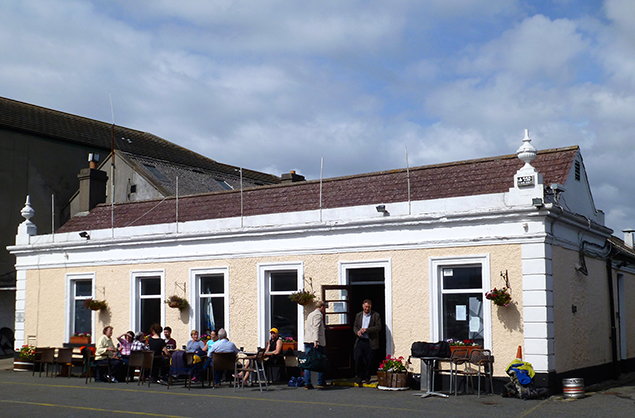
Another Clontarf factor which strangers find difficult is the existence of a busy road through the club’s dinghy park. Or at least it goes straight across the short distance from the dinghy park to the slipway. It’s something which the founders hadn’t planned. When Clontarf Yacht & Boat Club was set up in 1875, it established its HQ in a charming little shoreside farmhouse called Belvedere which was not only pleasantly south-facing, but had an uninterrupted and unrivalled view to the Dublin and Wicklow Mountains across the inner waters of Dublin Bay.
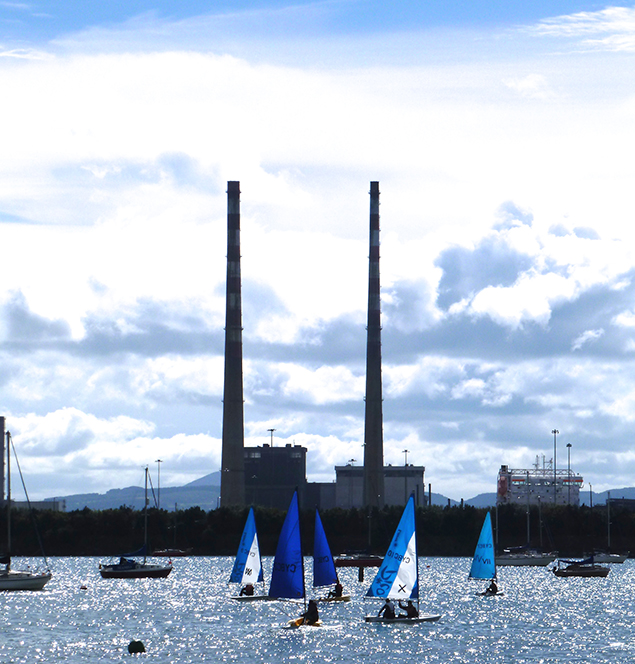 Clontarf Y & BC’s formerly clear view to the Wicklow Mountains is now somewhat interrupted, but the junior squad can still get in their training session afloat before the IDRA 14 fleet takes over the sailing water. Photo: W M Nixon
Clontarf Y & BC’s formerly clear view to the Wicklow Mountains is now somewhat interrupted, but the junior squad can still get in their training session afloat before the IDRA 14 fleet takes over the sailing water. Photo: W M Nixon
Over the years the clubhouse acquired some embellishments to become more pavilion-like, and what had been little more than a coastal path in front of it became almost roadlike as the built waterfront extended eastward. But thanks to the enormous presence of Lord Ardilaun’s St Anne’s Park estate further along the shore at Dollymount, the main road out to Howth continued to be the old post road going well inland through Raheny.
However, inevitably in time the James Larkin Road was created along the shore at Dollymount to provide a more direct main road to Howth, with traffic increasing year on year until now it seems to rumble by in a continuous stream between Belvedere and the sea.
In the circumstances, any club which wasn’t such an integral part of its community might well have considered re-location. But Clontarf Yacht & Boat Club is very much local and community-based, and it has adapted instead, even becoming accustomed to the fact that much of its once flawless view across the bay to the hills and mountains is now interrupted by the expansion of Dublin Port, with the latest addition to the intermediate skyline being the monumental new incinerator rapidly taking shape across in Ringsend.
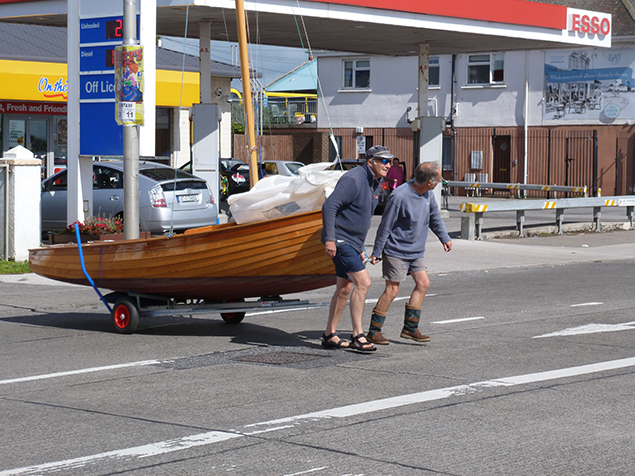
Yet if it’s a half decent sailing day, and the tide is flooding, Clontarf leaps to sailing life. On Sunday afternoon when the good weather mercifully lasted much longer than predicted, the place was buzzing not only with good-humoured aficionados of the IDRA 14 Class celebrating their boat’s 70th birthday, but with a host of trainee juniors who got in their sailing session before the fine fleet of historic IDRA 14s took over the stage for their concluding review of the fleet parked in line along the green, in readiness for launching and rounding out the celebrations with a Parade of Sail afloat mostly close along the waterfront, something which was most easily organized simply by making it a race.
Throughout it all, Sunday walkers and locals of every speed and type moved along Clontarf’s fine promenade mingling with the boats and boat people and everyone – whether sailors or not – seemed to know everyone else, or at least felt they did, while the multiple presence of cheerful dogs of all shapes and sizes improved things even further.

As to the business of getting your boat out of the dinghy park and across that busy road to the slipway, former Clontarf Y & BC Commodore Ian Sargent demonstrated the technique to perfection: “You just step out slowly, you’ll find the traffic starts to slow down, then as they see what’s going on they’ll come to a stop if need be as you walk across in confident but unhurried style. Then as you get safely across, it is absolutely imperative that you wave your thanks to all involved”.
It was primarily thanks to Ian Sargent and his tolerant wife Rebecca that last weekend’s celebrations took place. He is the total IDRA 14 nut, lovingly researching and recording the history of every boat back to that immediately post-war time of precious hope, but little else, in 1946. Back then, far-sighted people like Douglas Heard and Billy & Jimmy Mooney in Dun Laoghaire in November 1945 set in train the movement which became the Irish Dinghy Racing Association, and in so doing they reached out to other clubs nationwide in mutual support with fellow-enthusiasts.
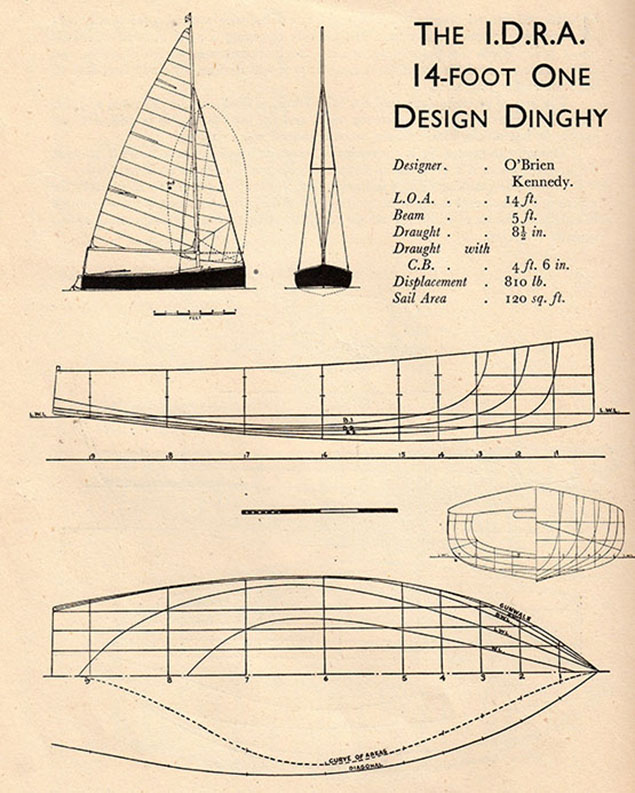 The IDRA 14 as first publicised in 1946. Within weeks, 46 boats were under construction by bot professionals and amateurs.
The IDRA 14 as first publicised in 1946. Within weeks, 46 boats were under construction by bot professionals and amateurs.
The flagship of the new Association became the IDRA 14, developed from a design by an Irish naval architect working in England, George O’Brien Kennedy. His period of working across the water was later fondly recalled by fellow yacht designer David Thomas, who used to say that Brian – as everyone knew him – would come up with more innovative boat ideas in a morning than the rest of the office produced all week.
Admittedly some of his ideas were frankly crazy. But in developing the design of the clinker–built IDRA 14 from a boat he’d designed for his own use in 1938 but whose possible expansion as a class was stymied by World War II in 1939, he produced an eminently sensible design which not only suited Irish needs at the time, but was also later successfully used in slightly modified form at three English sailing centres.
One of the clubs which immediately embraced the new Irish boats with huge enthusiasm was Clontarf Yacht & Boat Club, and it has remained such a stronghold of the class that the very newest IDRA 14, Wicked Sadie number 166, was timber built in classic style in a shed out the back of the club by a team co-ordinated by Rowan Melling, a two year project which reached it successful conclusion to considerable acclaim with Sadie’s Gala Launching at Clontarf on June 25th 2016.
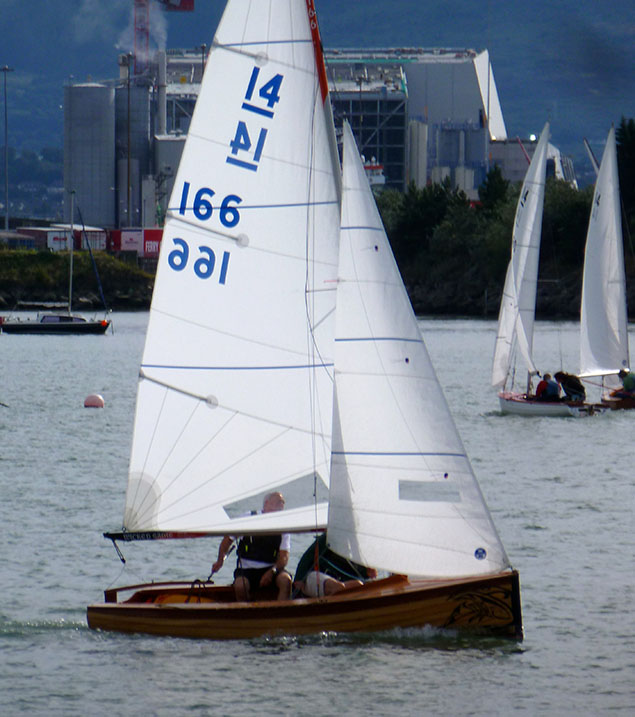 They’re both the newest things in town. The IDRA 14 Wicked Sadie was first launched on June 25th 2016, and beyond her is the newest part of the national infrastructure, the Ringsend Incinerator. Photo: W M NixonThe very first boats were built nearby in 1946, just across the Tolka Estuary from Clontarf in Jem Kearney’s boatyard at Dublin’s East Wall. A brother of the noted yacht designer and builder John Kearney, Jem was something of a rough diamond, but those who worked with him or learned something of the skills from his boat-building classes thought very highly of him and his work.
They’re both the newest things in town. The IDRA 14 Wicked Sadie was first launched on June 25th 2016, and beyond her is the newest part of the national infrastructure, the Ringsend Incinerator. Photo: W M NixonThe very first boats were built nearby in 1946, just across the Tolka Estuary from Clontarf in Jem Kearney’s boatyard at Dublin’s East Wall. A brother of the noted yacht designer and builder John Kearney, Jem was something of a rough diamond, but those who worked with him or learned something of the skills from his boat-building classes thought very highly of him and his work.
There isn’t the space here to detail the way the early sail numbers were allocated, as 46 boats were soon in various levels of construction – both by professionals and amateurs - from an early stage, and each club group which had signed up to the new class was given a batch of numbers with the boats getting afloat in random order.
Thus the first boat in commission was actually Number 14, Deirdre built by Jem Kearney for that renowned sailing cleric, the Reverend George Good, whose exuberant approach to life suggested that he might have felt much more at home in one of the livelier periods of the 18th Century. As to Deirdre, she almost immediately became a mystery which still hasn’t been explained to this day. All we really know is that in due course George God appeared with another new IDRA 14, but this time built by Walter Levinge of Athlone, yet still sporting sail Number 14 and still called Deirdre.
Meanwhile other boats were appearing in much more orthodox style in rapid succession, with Number 1 being built by Kearney for Douglas Heard himself, though quite why he called her Error we can only guess. But whatever the reason, she won the first championship in 1947, and she’s still gong strong and was at the Clontarf celebrations in the proud ownership of Jim Lambkin of Sutton Dinghy Club.

Next in line numerically at Clontarf on Sunday was a boat which has more than a few connections with this parish, but we’ll come to that anon. No 4 Dusk was another 1946-built Jem Kearney boat whose first owner was Hugh Allen, who went on to crew for Alf Delany in the Swallow Two-Man class in the 1948 Olympics, sailing in the first-ever Irish Olympic Sailing Team.
In return, Alf Delany then crewed for Hugh in Dusk in the 1949 IDRA Championships at Crosshaven at what was then the Royal Munster, and they won overall. This staging of an event at Crosshaven was a great boost to the class’s development in Cork, and the local firm DBL – Driscoll, Bushe & Leonard, with George Bushe and Dick Leonard the main partners – became much involved with their construction.
But Cork owners were as canny then as they are now, and in 1950 Crosshaven sailing brothers Barry and Harold Cudmore ordered a new IDRA 14 from George Bushe on condition that he’d won the nationals with her. George was as good a helmsman as he was a boatbuilder, so he cheerfully took up the challenge, built the boat, signed up the legendary Kevin O’Regan as crew (see Afloat obit) and off they went to the 1950 Nationals at Dromineer. And they duly won, which left the Cudmore brothers with boat now called Monaveen, and a very high standard of performance to maintain.
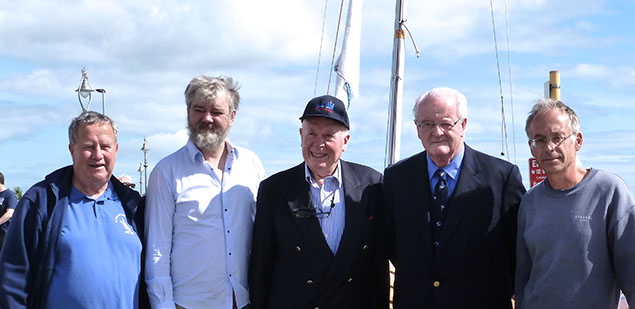
Histories of Ireland in the late 1940s and on through the 1950s paint the picture of a nation in total economic stagnation, yet the IDRA 14 class so captured the Irish sailing imagination that these became the class’s special years, good times which extended on into the early 1960s, for in 1960 the class had up-graded itself by permitting synthetic sails and adding a trapeze for zippier performance in a breeze.
The list of sailors who got involved with the IDRA 14s in these boom years reads like a Who’s Who of top Irish sailors, as people of the calibre of Douglas Heard, Jimmy Mooney, Hugh Allen, Jem Sullivan, Charlie Sargent and Peter Odlum were to be joined by the Cudmore clan, Denis Doyle, Conor Doyle, Joe Fitzgerald, Mick Sullivan, Ted Crosbie, Ian Morrison, Liam McGonagle, Desmond Keatinge, Bunny Conn, Roy Dickson, Dougie Deane, Jackie O’Reilly, Johnny Vaughan, Sid Shine, Philip Jacob, John Millar, John Godkin, Sean Flood, Clayton Love Jnr. and many others.
Crosshaven’s own Clayton Love Jnr’s involvement was undertaken with typical thoroughness, as he’d had George Bushe build him Miss Betty (IDRA 14 no 54) in 1949 with all those special skills which George Bushe could bring to a winning boat which was also a work of art. Then Clayton gave the IDRA 14 Class six years of his enthusiastic attention, winning just about everything with the Cork fleet, and taking the national title twice, in 1953 at Crosshaven, and 1955 at Dunmore East, crewed by Donal McClement in ’53 and Hugh Barry in ’55.
He then sold the boat on to Sean Flood of Clontarf, who in turn won the Nationals with her at Wexford in 1958 and Ballyholme in 1959. But by this time what had been Ireland’s premier dinghy class for a dozen years was beginning to feel the pinch as newer designs came forward, and several of the top IDRA 14 people moved into the exotic realms of the International 505 Class, which in Ireland became a sort of moveable feat, an elite group of upwards of a dozen top dinghy talents who might deign to take part in the annual IDRA Dinghy Week, but equally they might descend with their own road show on select places such as Dromineer on Lough Derg, where their activities afloat and ashore became the stuff of legend.
But while the exotic heights of the 505 class were all very well for those who could afford it, the solid citizens of the IDRA 14 class were determined to keep their much-loved boats as a viable racing option at both club and national level, and during the 1960s the contribution of the Sargent family to the class’s continuing health was remarkable.
The patriarch of the clan, Charlie Sargent, was general manager of timber merchants T & C Martin, so there were few people in Dublin who knew more about wood. But in his spare time, he was also a boat builder whose skills were way beyond those of many professionals, and near the family home firstly in Clontarf, and later in Sutton, he produced masterpieces of the boatwright’s art and craft.

He’d been involved with the IDRA 14s as both builder and owner since 1946, but it was in 1962 in Sutton, working with his son Gerry, that he built what many would reckon to be his masterpiece, no 38 Starfish. With her combination of clear spruce planks and a beautiful mahogany sheerstrake, for appearance Starfish has become the definitive IDRA 14 by which other boats are rated. And she soon proved herself a winner too – in 1963 Gerry Sargent, crewed by his brother Ian, won the Nationals at Skerries with her.
By this time the class had to face off another challenge, the increasing popularity of glassfibre construction for new dinghy classes, and here too the Sargent family played a key role in moving things forward. Much and all as Charlie Sargent loved building boats in classic style in wood, the class eventually persuaded him that they desperately needed a fibreglass hull option if they were to continue moving forward. Having accepted this, Charlie Sargent gave it his full support, and he built the plug for the mould for the new GRP hulls which were made by Delcraft of Malahide.
Then he and his family finished the bare hull with the deck and other wood trim to have her racing under Ian Sargent’s command as Sea Urchin 3 (later Swift, no 114) in the 1977 season, and by 1979 they had the GRP boats up to speed, with Ian winning the championship at Lough Ree.
The continuing health of the class then found another option in 1993 when the restored Dusk (no 4) was one of the star exhibits at the Dublin Boat Show. She’d been mouldering since 1978, but was brought back to classic life by Tom O’Brien and his son David, editor of Afloat Magazine, in a project with WEST System agents Waller & Wickham which showed that epoxy saturation techniques worked very well in restoring vintage IDRA 14s. A number of specialist firms were involved in the Dusk project, with Alistair Duffin of Belfast (best known as the top International GP 14 builder) installing the deck, centreplate casing and the thwarts in the bare hull as finished by the O’Briens, while Wicklow Marine Services were in charge of the final stages.
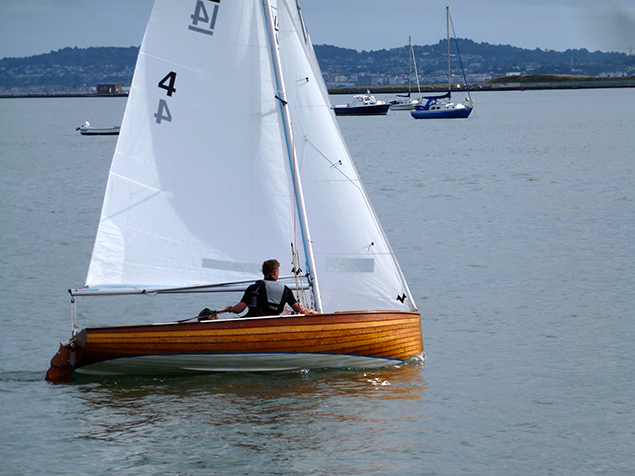 Originally built for Olympic sailor Hugh Allen in 1946, Dusk was restored in 1993 by Tom and David O’Brien in a demonstration of the potential of the WEST method. She placed second in Sunday’s 70th anniversary race. Photo: W M Nixon
Originally built for Olympic sailor Hugh Allen in 1946, Dusk was restored in 1993 by Tom and David O’Brien in a demonstration of the potential of the WEST method. She placed second in Sunday’s 70th anniversary race. Photo: W M Nixon
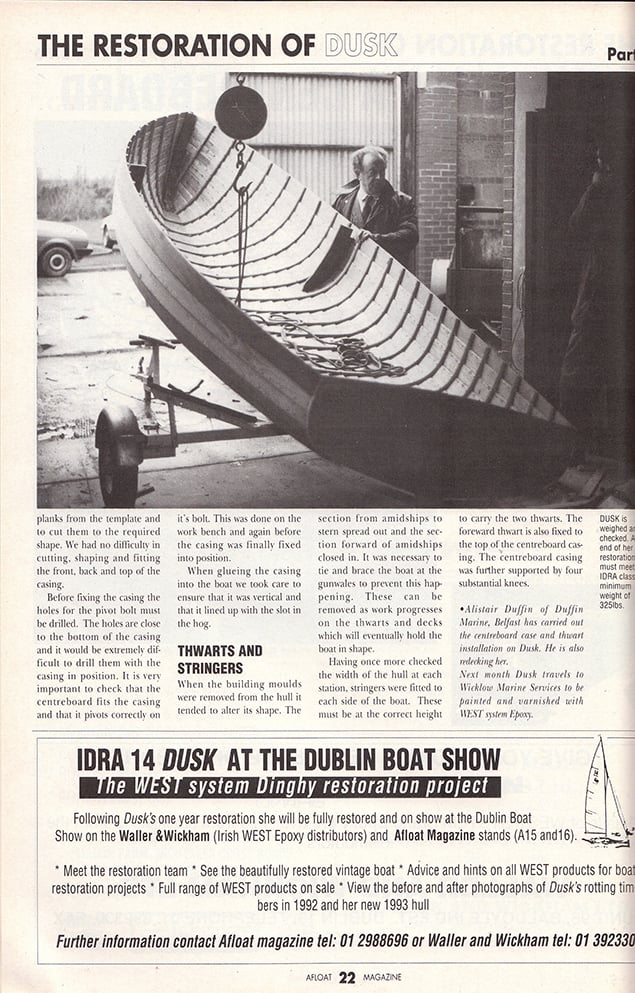 "A page from Afloat Magazine for January-February 1993, the photo showing Tom O’Brien with the restored bare hull of Dusk being weighed as part of the stringent measurement rules of the IDRA 14 Class and below a cutting from the April 1993 issue shows Dusk did indeed make it for the Dublin Boat Show in March
"A page from Afloat Magazine for January-February 1993, the photo showing Tom O’Brien with the restored bare hull of Dusk being weighed as part of the stringent measurement rules of the IDRA 14 Class and below a cutting from the April 1993 issue shows Dusk did indeed make it for the Dublin Boat Show in March

David O’Brien had a successful year racing Dusk, taking the runner-up slot in the Nationals in 1993 at Carlingford to the evergreen Starfish (Terry Harvey, Sutton). Subsequently he moved into Fireballs with John Lavery with such success that by 1995 they were World Champions, but Terry Harvey went on to reap continuing success with Starfish in the IDRA 14s, with more championship wins than anyone else.
However, others have got in on the act, and the milestone of a first woman champion was reached by Scorie Walls of Sutton racing Chance (no 163) at Galway Bay in 2000, and she retained the title the following year at Lough Ree racing Starfish. As for the first all-female crew to take the title, that came in 2012 on Lough Erne when Julie Ascoop of Clontarf crewed by Heather Keenan won in Chaos.
The rich texture of the class’s history over the years has always been something to celebrate, and it was very special when O’Brien Kennedy himself turned up to be the Guest of Honour at the Golden Jubilee in 1996. The golden thread of the storyline in Ireland has been further reinforced by developing contacts with the sole remaining class of sister-ships, the Dragonflies at Waldringfield in Suffolk in the east of England on the lovely River Deben.

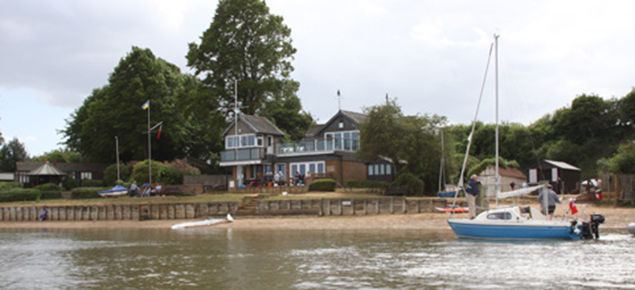
The Dragonflies were founded in 1949, so when their 70th birthday comes along in 2019, a strong contingent of IDRA 14 sailors will be descending on Waldringfield and doubtless putting much business the way of the famous Maybush Inn as well as the bar of Waldringfield SC. But meanwhile the news from Suffolk was that classic boat enthusiast James Palmer, a former engineer but now born-again traditional boatbuilder, had just built the newest Dragonfly in classic style, so Ian Sargent set to work persuading him and ten of his fellow club members to come to Ireland for last weekend’s party at Clontarf, bringing the new boat Phoenix with them. It all came together in time, and there we were last Sunday in sunny Clontarf with upwards of thirty IDRA 14s of all vintages lined up along the promenande, with the new Wicked Sadie and the new Phoenix in pride of place, when the magic ingredient was added.
Clayton Love Jnr, IDRA 14 Champion in 1953 and 1955, and Sean Flood, IDRA Champion in 1958 and 1959, turned up to wish everyone well and inspect the fleet and then see the Parade of Sail, which already had all the makings of a good race.
But we’d to wait a while for it, for it seems that once you’re an IDRA 14 man you’re always an IDRA 14 man, regardless of the many famous boats with which you’ve been subsequently associated. So the two legends of the class’s history took their time in inspecting the fleet, having a particularly long chat with Jim Lambkin with Error, the boat with which Douglas Heard won the first championship in 1947.
The links with the past were then completed with the arrival of Shane O’Brien Kennedy, son of the late designer, who was soon fitted up with a berth for a race in which the Dragonfly visitors from Waldringfield were also spread through the fleet.
James Palmer himself raced Phoenix in what seemed at first a slightly unfair match, as the Waldringfield class have adhered strictly the their original 1949 specification, including wooden spars and traditionally-shaped sails, whereas the IDRA 14s have long since been into alloy spars with a rig as souped-up as it can be, with most of the top boats now setting sails made by Dick Batt, though it was very evident that Wicked Sadie has preferred North.
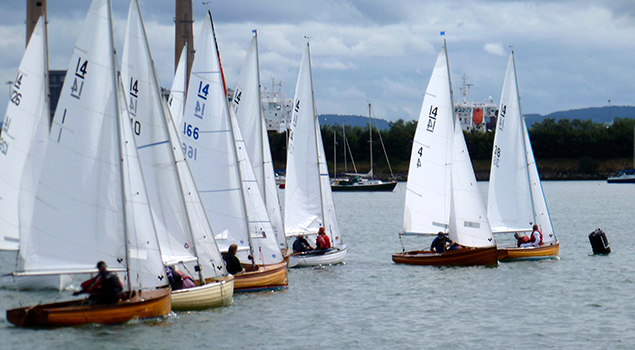 Seconds to go to the start….Gerry Sargent in Starfish (38) is exactly where he wants to be, and so too is Neil Cawthorn with Dusk (4). Photo: W M Nixon
Seconds to go to the start….Gerry Sargent in Starfish (38) is exactly where he wants to be, and so too is Neil Cawthorn with Dusk (4). Photo: W M Nixon
But handsome is as handsome does, and there was no avoiding the imperatives of history. Shaping up for the start, Gerry Sargent sailing Starfish with Ian McCormick as crew was right there on the pin to keep himself on the left hand side of the first beat. Neil Cawthorn of Waldringfield with Andy Sargent on Dusk nipped past his stern on port but clear across the rest of the fleet still on starboard.
Most of them were keen to get onto port as soon as possible for the traditional win move along the Clontarf wall in the very last of the flood, with no lack of useful advice from helpful promenadeers within yards of them. But out on the left was the place to be, and Gerry Sargent scrunched Starfish up to the mid-river line of breeze at every opportunity, sailing in clear wind when fleet numbers meant that few other boats always had clean air, and Starfish had a fine lead from Dusk at the first mark.
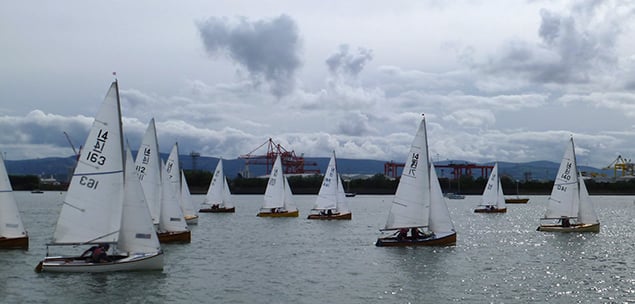
The wind lightened in the two long reaches to take in the south mark, and by the time the leaders were approaching the lee turn down toward the Royal Dublin Golf Club, the ebb had started as Gerry Sargent came round the mark with an enormous lead, and still next in line, and now equally clear of the boats behind, was Dusk, while in the midst of the tail-enders was Phoenix, feeling very far from home in the green fields of Suffolk.
But once the ebb starts running at Clontarf, it doesn’t hang about. It fairly sluices along the promenade and over the Clontarf slip, swirling towards the North Bull Wall. Yet having been so far ahead, Starfish had much less of this adverse tide, which only increased her enormous lead and she was able to work along the shore using the slightly better breeze there nearing the finish, as too was Dusk, though by now quite some time later.
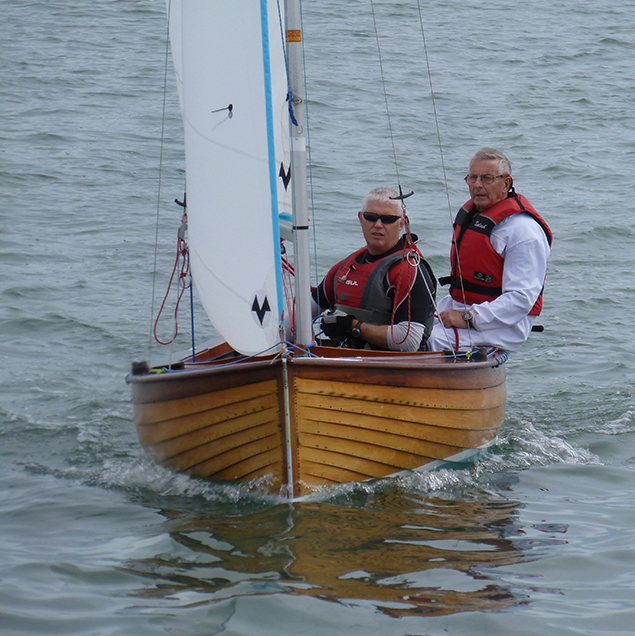
But the rest of the fleet were getting in each other’s way hoping to find an eddy right inshore east of the slip. It was their undoing. James Palmer sensibly kept himself clear of this melee, and sought the new breeze out towards the middle. It paid off big time. Phoenix went from crab grass to contender in that final beat, and finished sixth with dozens of supposedly hotter boats well behind her.
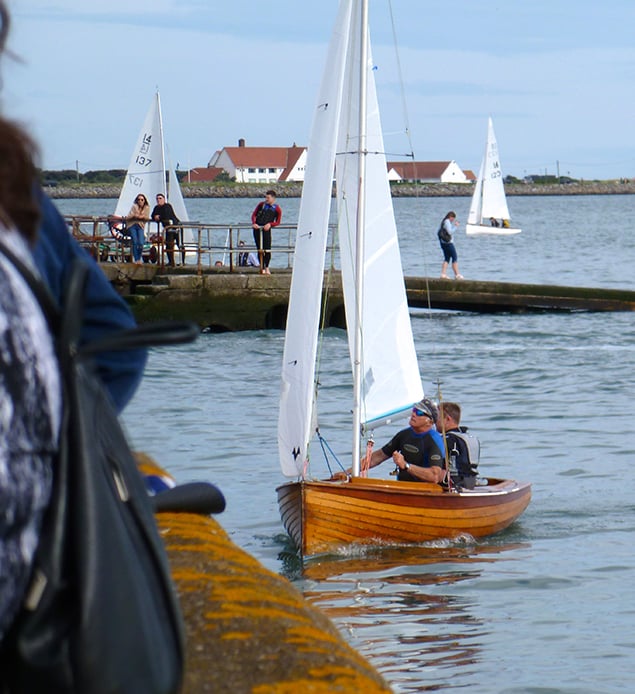 Promenade racing. Dusk closing in on second place, with the Royal Dublin Golf Club in the background. Photo: W M Nixon
Promenade racing. Dusk closing in on second place, with the Royal Dublin Golf Club in the background. Photo: W M Nixon

It was a fairytale ending to a magic day. The winner was the most beautiful boat in the class, sailed by a man who built this most beautiful boat with his father 54 years ago. Second place was filled by the boat which won the championship in 1949, a boat which, in this year of Irish Olympic sailing medals, gives us a direct link back to that very first Irish Olympic team of 1948. She is also the boat which, in 1993 in another father-and-son project, showed what can be done to keep a classic IDRA 14 in good order through the newest techniques. And in a very honourable sixth place, there was a visitor who had come a long distance in many ways in order to join the IDRA 14 class in celebrating their 70th birthday.
It was a day to remember and cherish, so here’s the list of the top six: 1st Starfish (1962, sailed by Gerry Sargent); 2nd Dusk (1946, sailed by Neil Cawthorn); 3rd Siobhan (1979, sailed by Louise McKenna); 4th Delos 2 (1953, sailed by Derek Jacobs); 5th Slipstream (1978, sailed by David Rowland), 6th Phoenix (Dragonfly, 2016, sailed by James Palmer).
And if you’re minded to absorb further the special nature of the IDRA 14 Class, this video below from the 1950s which Lough Derg YC presented to the class when they held their 2016 Nationals down there three weeks ago, the winners being Alan Henry and Simon Revill from Sutton.
IDRA 14 Dinghy Will Celebrate 70th Anniversary In Style At Clontarf Yacht & Boat Club
It takes a leap of the imagination to realise what a remarkable breakthrough the introduction of the Irish Dinghy Racing Association 14ft One Design represented in 1946 writes W M Nixon. But the 70th Anniversary celebrations of this ever-young classic dinghy at Clontarf Yacht & Boat Club on the weekend of September 3rd and 4th will be a reminder of the contribution of a very special boat towards making Ireland the sort of sailing nation where Olympic medals come within the range of possibility and achievement.
The new boat came like a breath of fresh air in the post-war time of uncertainty, when everybody knew that Irish sailing was going to have to go in a new direction if it was to go anywhere, but precisely what that direction might be was a matter of debate and uncertainty.
The formation of a specifically dinghy-sailing national body was a first step, and the importation of the new Uffa Fox-designed mass-produced 12ft–Firefly gave a glimpse of the future. But what was also needed was a slightly larger modern boat with a distinctively Irish tinge.
Fortunately a young Irish yacht and boat designer, O’Brien Kennedy, was working in England, and he was keyed in to the latest concepts in racing dinghies. He had produced plans for clinker-built dinghies for racing which reflected the latest hull design trends, and it was felt that one of his designs would - with several modifications - be suitable to provide the IDRA with a 14ft dinghy to go with the Firefly in spreading the concepts of modern dinghy racing throughout Ireland.
 The first public appearance – O’Brien Kennedy’s drawings for the new IDRA 14 as they appeared in The Yachting Year Annual 1946-47.
The first public appearance – O’Brien Kennedy’s drawings for the new IDRA 14 as they appeared in The Yachting Year Annual 1946-47.
In fact, such was the interest and enthusiasm reaching O’Brien Kennedy from would-be owners in Ireland that he produced what were in effect the plans of a new boat, and in a matter of weeks forty-six of the new IDRA 14s were in the pipeline, either from commercial builders, or from capable enthusiasts so keen to get the new class into being that they were game to have a go at building the boats themselves.
They were profoundly satisfying boats to build, as O’Brien Kennedy had produced a set of lines which resulted in beautifully sweeping clinker-planked hulls, something which has been shown to perfection in the most recent boat Wicked Sadie, amateur built to professional standards by a group at Contarf, and much admired wherever she goes since her launching on June 25th this year.
So it’s appropriate that Clontarf is going to be the setting for celebrating the Class’s 70h birthday, as it was a hotbed for IDRA 14 growth in the late 1940s, with one leading local sailor so keen to get the show on the road that he donated one of the new boats to be the prize in a raffle.
IDRA 14 Champions 1947 – 2015
| Year | Venue | Boat Name | Sail No. | Helm | Club | Crew | Club |
|---|---|---|---|---|---|---|---|
| 1947 | Royal St George YC | "Error" | 1 | R.D. (Douglas) Heard | RstGYC | ||
| 1948 | Lough Ree YC | "Dawn" | 8 | A.J. (Jimmy) Mooney | RstGYC | ||
| 1949 | Royal Munster YC | "Dusk" | 4 | R.H. (Hugh) Allen | RstGYC | Alf Delany | RstGYC |
| 1950 | Lough Derg YC | "Monaveen" | 56 | George Bushe | RMYC | Kevin O'Regan | RMYC |
| 1951 | Waterford Harbour SC | "Mystery" | 51 | C.J. (Joe) Fitzgerald | RMYC | Michael Donnelly | RMYC |
| 1952 | Lough Ree YC | "Sheldrake" | 36 | Noel (Bunny) Conn | SDC | Mary Conn | SDC |
| 1953 | Royal Munster YC | "Miss Betty" | 54 | J. Clayton-Love Jnr | RMYC | Donal McClement | RMYC |
| 1954 | Skerries SC | "Coulin" | 7 | J.K. (Jackie) O'Reilly | CY&BC | Patricia O'Reilly | CY&BC |
| 1955 | Waterford Harbour SC | "Miss Betty" | 54 | J Clayton-Love Jnr | RMYC | Hugh Barry | RMYC |
| 1956 | Lough Derg YC | "Coulin" | 7 | J.K. (Jackie) O'Reilly | CY&BC | G.M. (Gerry) Sargent | CY&BC |
| 1957 | Royal Munster YC | "Coulin" | 7 | J.K. (Jackie) O'Reilly | CY&BC | Tommy O'Reilly | CY&BC |
| 1958 | Wexford Harbour BC | "Miss Betty" | 54 | Sean Flood | CY&BC | Brian McNally | CY&BC |
| 1959 | Ballyholme YC | "Miss Betty" | 54 | Sean Flood | CY&BC | Brian McNally | CY&BC |
| 1960 | Baltimore SC | "Coulin" | 7 | J.K. (Jackie) O'Reilly | CY&BC | Gerry Burke | CY&BC |
| 1961 | Royal Munster YC | "Sheldrake" | 36 | Robert Hogg | SDC | Des O'Shea | SDC |
| 1962 | Skerries SC | "Starfish" | 38 | G.M. (Gerry) Sargent | SDC | Ian Sargent | SDC |
| 1963 | No event held that year as Class Association declined to compete in "Dinghy Week" in Dun Laoghaire | ||||||
| 1964 | Baltimore SC | "Dryad" | 104 | P.R. (Philip) Jacob | WHSC / RstGYC | Bill Pigot | RstGYC |
| 1965 | Royal Munster YC | "Coulin" | 7 | J.K. (Jackie) O'Reilly | CY&BC | Gerry Burke | CY&BC |
| 1966 | Ballyholme YC | "Daydream" | 111 | J.S. (John) Godkin | KYC | Clive Latchford | KYC |
| 1967 | Royal Cork YC | "Sheldrake" | 36 | J.L.W. (John) Miller | RstGYC | Michael Toomey | RstGYC |
| 1968 | Strangford Lough YC | "Sheldrake" | 36 | J.L.W. (John) Miller | RstGYC | Michael Toomey | RstGYC |
| 1969 | Baltimore SC | "Sheldrake" | 36 | J.L.W. (John) Miller | RstGYC | Michael Toomey | RstGYC |
| 1970 | Lough Derg YC | "Chloe" | 30 | Eric Allen | CY&BC | Brian Hurding | CY&BC |
| 1971 | Wexford Harbour BC | "Chloe" | 30 | Eric Allen | CY&BC | Brian Hurding | CY&BC |
| 1972 | Malahide SC (MYC) | "Chloe" | 30 | Eric Allen | CY&BC | Brian Hurding | CY&BC |
| 1973 | Mullingar SC | "Sheldrake" | 36 | J.L.W. (John) Miller | RstGYC | Michael Toomey | RstGYC |
| 1974 | Waterford Harbour SC | "Dainty" | 2 | John & Rosemary Doorly | RstGYC | Rosemary Doorly | RstGYC |
| 1975 | Tralee SC | "Cheetah" | 65 | E.F. (Teddy) Chandler | CY&BC | Cormac Smyth | CY&BC |
| 1976 | Sligo YC | "Daydream" | 111 | Terry Demsey | CY&BC | Sean Deane | CY&BC |
| 1977 | Lough Ree YC | "Chloe" | 30 | Terry Demsey | CY&BC | Sean Deane | CY&BC |
| 1978 | Sligo YC | "Starfish" | 38 | Terry Harvey | SDC | Joe Brennan | SSBC |
| 1979 | Lough Ree YC | "Sea Urchin IV" | 136 | Ian Sargent | CY&BC / SDC | Frank O'Gorman | CY&BC / SDC |
| 1980 | Royal Cork YC | "Sea Urchin IV" | 136 | Ian Sargent | CY&BC / SDC | Frank O'Gorman | CY&BC / SDC |
| 1981 | Lough Derg YC | "Starfish" | 38 | Terry Harvey | SDC | John Hensey | SDC |
| 1982 | Sligo YC | "Sea Urchin IV" | 136 | Ian Sargent | CY&BC / SDC | Frank O'Gorman | CY&BC / SDC |
| 1983 | Sligo YC | "Starfish" | 38 | Terry Harvey | SDC | Scorie Walls | SDC |
| 1984 | Lough Derg YC | "Starfish" | 38 | Terry Harvey | SDC | Scorie Walls | SDC |
| 1985 | Dundalk SC | "Starfish" | 38 | Terry Harvey | SDC | Scorie Walls | SDC |
| 1986 | Skerries SC | "Starfish" | 38 | Terry Harvey | SDC | Scorie Walls | SDC |
| 1987 | Wicklow SC | "Starfish" | 38 | Terry Harvey | SDC | Scorie Walls | SDC |
| 1988 | Sligo YC | "Dainty" | 2 | Andrew Mollard | RstGYC | Paul Conway | RstGYC |
| 1989 | Waterford Harbour SC | "Starfish" | 38 | Terry Harvey | SDC | Scorie Walls | SDC |
| 1990 | Galway Bay SC | "Starfish" | 38 | Terry Harvey | SDC | Scorie Walls | SDC |
| 1991 | Waterford Harbour SC | "Starfish" | 38 | Terry Harvey | SDC | Scorie Walls | SDC |
| 1992 | Galway Bay SC | "Delos II" | 15 | Pat O'Neill | CY&BC | Jim O'Hara | CY&BC |
| 1993 | Dundalk SC | "Starfish" | 38 | Terry Harvey | SDC | Scorie Walls | SDC |
| 1994 | Wicklow SC | "Delos II" | 15 | Pat O'Neill | CY&BC | Jim O'Hara | CY&BC |
| 1995 | Dundalk SC | "Starfish" | 38 | Terry Harvey | SDC | Scorie Walls | SDC |
| 1996 | Lough Ree YC | "Starfish" | 38 | Terry Harvey | SDC | Scorie Walls | SDC |
| 1997 | Royal Cork YC | "Delos II" | 15 | Pat O'Neill | CY&BC | Jim O'Hara | CY&BC |
| 1998 | Lough Ree YC | "Starfish" | 38 | Terry Harvey | SDC | Scorie Walls | SDC |
| 1999 | Dundalk & Carlingford SC | "Dunmoanin" | 140 | Frank Miller | DMYC | Claire Sheil | DMYC |
| 2000 | Galway Bay SC | "Chance" | 163 | Scorie Walls | SDC | David Tillotson | SDC |
| 2001 | Lough Ree YC | "Starfish" | 38 | Scorie Walls | SDC | Colm O'Neill | SDC |
| 2002 | Galway Bay SC | "Charmian" | 28 | Alan Henry | SDC | Gerry O'Hanlon | SDC |
| 2003 | Lough Erne YC | "Charmian" | 28 | Alan Henry | SDC | Gerry O'Hanlon | SDC |
| 2004 | Wexford Harbour B&TC | "Charmian" | 28 | Alan Henry | SDC | Gerry O'Hanlon | SDC |
| 2005 | Galway Bay SC | "Delos II" | 15 | Pat O'Neill | CY&BC | Jim O'Hara | CY&BC |
| 2006 | Lough Erne YC | "Starfish" | 38 | Alan Carr | SDC | Barry Kelly | SDC |
| 2007 | Carlingford Lough YC | "Slipstream" | 125 | Alan Henry | SDC | William Gordon | SDC |
| 2008 | Sligo YC | "Starfish" | 38 | Alan Carr | SDC | Aoibhin de Burca | SDC |
| 2009 | Newtownards SC | "Starfish" | 38 | Alan Carr | SDC | Aoibhin de Burca | SDC |
| 2010 | Lough Ree YC | "Delos II" | 15 | Pat O'Neill | CY&BC | Jim O'Hara | CY&BC |
| 2011 | Galway Bay SC | "Slipstream" | 125 | Alan Henry | SDC | Simon Revill | SDC |
| 2012 | Lough Erne YC | "Chaos" | 143 | Julie Ascoop | CY&BC | Heather Keenan | CY&BC |
| 2013 | Lough Ree YC | "Starfish" | 38 | Alan Carr | SDC | Ian McCormack | SDC |
| 2014 | Carlingford SC | "Delos II" | 15 | Pat O'Neill | CY&BC | Jim O'Hara | CY&BC |
| 2015 | Lough Ree YC | "Dubious" | 134 | Alan Henry | SDC | Simon Revill | SDC |
The detailed listing of the Class Champions since 1947 deserves the closest study, for it shows just how central to the development of Irish sailing the IDRA 14 became. Just about every area of sailing, both inshore and offshore, dinghy and keelboat, has seen IDRA 14 sailors becoming involved to make a major contribution at the top levels, and the friendships formed have lasted down the years.
Thus the big party at Clontarf in the first weekend of September is going to work at many levels. And it even has an international aspect, as a sister class of the IDRA 14 is the Dragonfly at Waldringfield in Suffolk in eastern England. The newest Dragonfly – built last year – is going to be brought to Clontarf, accompanied by a party of eleven Dragonfly sailors.
Longtime IDRA 14 sailor and former Clontarf Y & BC Commodore Ian Sargent is at the heart of this remarkable celebration, which is going to lay on a major welcome for IDRA 14 sailors past and present. He can be contacted through [email protected], mobile 087-6791069, landline 01-8322196.
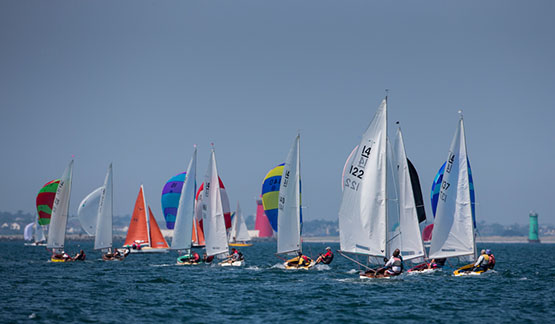 A class in good heart – the modern IDRA fleet, seen here racing in the Volvo Dun Laoghaire Regatta, incudes both timber and GRP boats. Photo courtesy VDLR
A class in good heart – the modern IDRA fleet, seen here racing in the Volvo Dun Laoghaire Regatta, incudes both timber and GRP boats. Photo courtesy VDLR





























